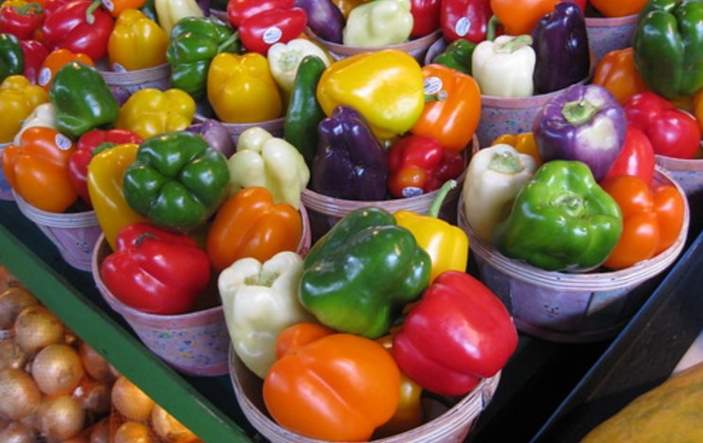Bell peppers are Capsicum annuum fruits belonging to the Grossum cultivar often placed into the sweet pepper group since they are mild or less pungent. They are the only ones that don’t produce capsaicin in the whole of genus Capsicum, i.e., they are zero heat.
Capsaicin is the main ingredient in chilies that produces a burning sensation when it comes in contact with any mammalian mucous tissues or what makes them hot.
Most people eat bell pepper as a side dish, vegetable ingredient, or for flavoring dishes. It may be part of garden salads, a pizza and cheesesteaks toppings, stuffed peppers, or you can use it to make paprika. However, botanically, like tomatoes, it is fruits, and to be more specific, berries and not a vegetable.
Can rabbits have bell pepper?
Yes. Rabbits can have rabbit bell pepper, also known as sweet pepper, capsicum, or just pepper, as a crunchy treat. The more common red, green, yellow, orange bell peppers, as well as the less common brown, white, lavender, or dark purple, are safe for rabbits. However, this is not the same case with hot or chili pepper like cayenne, Jalapeño, Poblano, Shishito, and others. Don’t give them to your bunnies as they cause a burning sensation.

Your rabbit will enjoy its taste and crunchiness. Also, capsicums are rich in vitamin C and a good source of vitamin B6 and some smaller quantities of vitamins B2, E, and K folate, as well as manganese.
Besides vitamin C and E, they are also rich in antioxidants, especially carotenoids. The red bell pepper is rich in a highly potent antioxidant known as capsanthin that gives them their characteristic vivid red color. Also, they have twice as much vitamin C and eight times more vitamin A when compared to green ones.
On the other hand, yellow bell pepper has violaxanthin, while green or unripe bell peppers are rich in lutein, which helps improve eyesight.
Also, these sweet pepper have quercetin, a type of polyphenol antioxidant that beneficial preventing heart diseases, cancer, and other chronic illnesses, as well as luteolin, another polyphenol antioxidant that has several health benefits.
Finally, don’t forget to have capsicum too. It is good for improve your eyesight, preventing anemia, among other health benefits.
Feeding bell pepper to your bunny
When offering it to your furry friends, do it as you do with other non-leafy vegetables, i.e., rabbits can have a teaspoon per two pounds of their body weight 1-2 times a week as a treat as you keep varying on treats you give them.
There may be a temptation to let your bunny have more. Even if these critters seem to like bell peppers, don’t overdo it. While they are not high in carbs like others, their fiber content is low, yet bunnies depend on high fiber diets to promote a healthy gut and motility.
Also, ensure all treats you give your pet, including fruits, herbs, flowers, other non-leafy veggies, or commercial rabbit treats, don’t exceed 5% of their daily calorific intake.
Since it is low in fiber, let your bunny have about a teaspoon per two pounds of their body weight.
Always give them fresh capsicum, preferably an organic one. Begin with a small bit and wait for 24 hours to see how their delicate tummies will react to it and introduce only one new food at a time. If you don’t see loose stool, gas, or bloating, increase the amount gradually.
Finally, don’t give your bunnies cooked bell pepper or any other food. Even in the wild, these animals don’t eat cooked foods. Furthermore, cooking doesn’t modify them, including their fiber and nutritional composition.
Is pepper plant safe to bunnies?
No. It is not safe. If you happen to plant your own, pepper plants (leaves, stem, or flowers) don’t let your bunnies eat them.
Like all other members of the nightshade family, they have solanine, which is toxic to rabbits and other animals. It is the same reason why rabbits cannot eat tomatoes, potatoes, eggplants, and others.
Solanine is an alkaloid toxin meant to offer protection to nightshade plants against insects, fungi, bacteria, insects, or other animals. If ingested in large amounts, it can cause toxicity.
More on capsicum
Peppers are native to Central America, South America, and Mexico. Depending on where you come from, this berry may have different names. For instance, in Canada, the US, and the Philippines, it is known as bell pepper, while in the UK and Ireland, they call it pepper or sweet pepper.
In countries like Australia, New Zealand, Malaysia, Pakistan, and India, it goes by the name capsicum. All these are general terms that may not tell you more about their color but more of their bell-like shape.
Conclusion
The recommended rabbit foods make it confusing on which ones to go for and which ones to avoid. However, one fundamental way to a healthy bunny is to give them a variety of foods without compromising on the right proportions.
Your rabbits should have 80% grassy hay, 5% high-quality pellets, and 10-15% fresh foods and up to 5% treats. Fresh foods are mainly leafy greens and veggies while the rest can part of the treats, mostly fruits, non-leafy veggies, herbs, or flowers.
